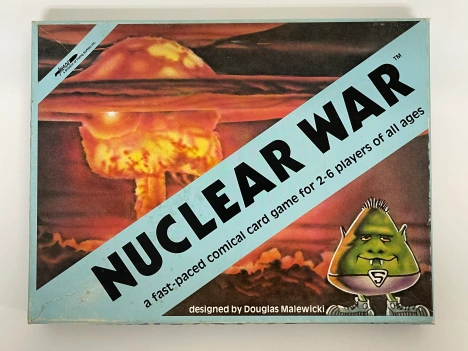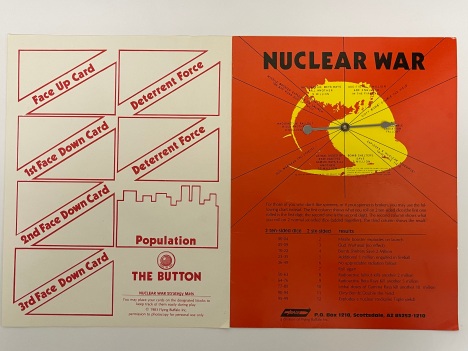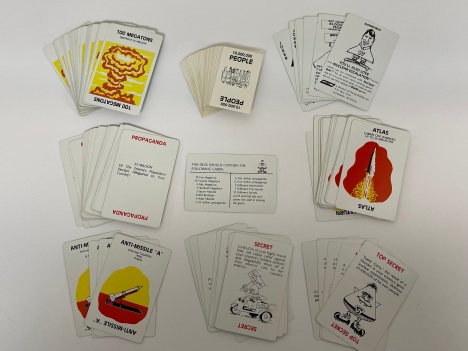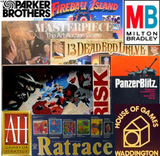 The 1970s was a time of powerhouse board game companies, with Parker Brothers, Waddingtons House of Games, and Milton Bradley hitting their stride, but there was room in the game market for a small, nimble company to sell games that the larger companies would not. Gamma Two Games was such a company, founded principally by Tom Dalgliesh. I asked Mr. Dalgliesh to clarify some of the historical record in regards to Gamma Two Games – which he kindly did – and his comments are interspersed throughout this discussion.
The 1970s was a time of powerhouse board game companies, with Parker Brothers, Waddingtons House of Games, and Milton Bradley hitting their stride, but there was room in the game market for a small, nimble company to sell games that the larger companies would not. Gamma Two Games was such a company, founded principally by Tom Dalgliesh. I asked Mr. Dalgliesh to clarify some of the historical record in regards to Gamma Two Games – which he kindly did – and his comments are interspersed throughout this discussion.
Scottish born Tom Dalgliesh emigrated to the Canada in 1967, and graduated from Simon Fraser University with a BA in History (Honors) by 1971. As he enjoyed playing wargames, Dalgliesh decided that designing wargames would be equally enjoyable, and so he and two other partners (Lance Gutteridge and Steve Brewster) formed their own game company in 1972: Gamma Two Games. Their partnership changed quite quickly, however, as Mr. Dalgliesh explains:
Steve left quite early. Our initial seed investment was $100 each. But Steve opted out when we needed further investment of $1000 each. Steve was a high school teacher until he retired a few years ago.

Quebec 1759, Gamma Two Games
Their first offering, Quebec 1759, fit this mold, a historical wargame (Canadian history, no less!), based on the pivotal battle on the Plains of Abraham between English and French forces which ultimately led to France’s exit from North America, as did their next game released in 1973, War of 1812 (a game based on the two year conflict between the United States and Canada, well, the British Empire, but let’s not quibble), and the next release in 1974, Napoleon: The Waterloo Campaign (based on the conflict between France and everybody else in the European Lowlands which decided Napoleon’s fate). All of these games were based on interesting and pivotal conflicts in the history of warfare in Western civilization during the 18th and 19th Centuries.

Airline, 1975 Gamma Two Games
However, the company’s 1975 game releases, Airline, Klondike, and Team broke away from the wargame motif, and were done in a more traditional board game style. Airline was a game about establishing travel routes between various cities and cornering the landing rights in enough airports to achieve dominance in the airline industry (and came complete with little plastic airplane tokens – never underestimate the power of little airplane tokens!). Klondike was a game based on the Canadian Gold Rush, wherein players make their money prospecting for gold on one part of the game board, and then buy up properties to charge exorbitant rents on the other part of the game board. The “anything can happen” feel of the Klondike Gold Rush era was duplicated by the game, including the “riches-to-rags” possibility! (The game was even endorsed by noted Canadian historian and author, Pierre Burton.) Finally, Team was a strategy game based on managing a hockey team to make the playoffs (and then hopefully win it all!), which included drafting and trading players. It was later re-released as Slapshot.
Compared to the first three games, the next three releases of Gamma Two Games were completely different. Why make the change from wargames to board games? Mr. Dalgliesh explained the decision succinctly as:
Just a desire to sell more games. Wargames then (and still) are more a labor of love than good business sense.

Star Wars 1977 Gamma Two Games
More traditional board games followed, with The Last Spike in 1976 (a game based on the race to build a railway system across Canada from sea to shining sea), UFO: A Game of Close Encounters, also in 1976 (a game where one player defended the Earth from alien invasion, while the other player attempted to overcome those defenses and land his alien forces), and Star Wars in 1977 (another two player game wherein each player attempts to destroy their opponent’s fleet and capture their home star). The latter two games are interesting in the timing of their release, what their titles are, and when the movies Close Encounters of the Third Kind and Star Wars hit the theaters. I asked Mr. Dalgliesh if Gamma Two Games had attempted to ride the coattails of the Spielberg and Lucas blockbusters:
The games were both developed before Star Wars. UFO came out unrelated to the Close Encounters movie. Star Wars came out three weeks AFTER the move and was, in effect, a very lucky break. I had heard the name being used in promo for the movie and I liked it for the game we were developing. There is no relationship between our game and the movie except the name. Like most others in the business, I had no idea that Star Wars would become the franchise it became. 20th Century Fox purchased our trademark name for their own use in Canada, a board game licensed to Parker Brothers.
It is true that no one had any idea that Star Wars was going to be a culture-changing phenomena, and it’s original trailer clearly shows that 20th Century Fox weren’t aware of the possibility, either. Actually, the 1970s was a decade that saw a huge upswing in public interest for all things Sci-Fi. Popular television series included such classics as The Six Million Dollar Man, Planet of the Apes, and The Bionic Woman. (As well as some less popular, but still classic series, such as Logan’s Run, Star Trek: The Animated Series, and Space: 1999.) After Star Wars was released, even more TV shows appeared, including the classic Battlestar: Galactica and Buck Rogers in the 25th Century. So science fiction themed board games were an excellent strategy to ride the wave of Sci-Fi’s cultural popularity. (Incidentally, the Star Wars game Mr. Dalgliesh refers to is the 1977 board game that Kenner sold in the United States, and Parker Brothers sold in Canada.) As for Gamma Two Games’ Star Wars game, it was re-branded as Starlord (and even had a box redesign in its 1977 re-release to further differentiate it from its original incarnation!).

Starlord (formerly Star Wars) Gamma Two Games
More games followed, with Supermoney, Bacchus: The Ancient Roman Game of Skill and Strategy, and the hilariously unique Smokers Wild in 1978; Maneuver and Foreign Exchange in 1979; Score! Soccer Game in 1980; and, capitalizing on the success of the first “Wild” 1978 release, Lovers Wild and Drinkers Wild in 1981. Clearly the decision to move away from wargames to traditional board games was a fiscally sound one for the young company. As Mr. Dalgliesh has stated elsewhere, Quebec 1759 sold around 20,000 units (which he attributed to being distributed in department stores), which was a success for a wargame (5,000 units being deemed a good seller with modern wargames). I asked him if any other games approached that level of success:
Sure, Klondike sold about 30,000 and Smokers Wild 80,000.

The first Hârn advertisement, found in a 1983 Dragon Magazine.
So if Gamma Two Games was a niche player in the board game market that was having success, where did it go? The answer is quite straightforward: it just changed its name! In 1983, Gamma Two Games relocated to the United States, and the company became Columbia Games. The company returned to its roots, releasing a slate of well-received and well-reviewed wargames, such as Richard III: War of the Roses, Julius Caesar, Eastfront and the epic Eurofront, as well as the Hârn roleplaying system. Columbia Games has since re-released its original wargames, Quebec 1759 and War of 1812, and they are not done with their old game catalog yet:
We are actually planning to release new editions of Last Spike and Klondike soon. Later this year or next.
This is wonderful news, as reprinting old titles in the company’s game catalog speaks to the soundness of their financial position. Hopefully a new generation of board game enthusiasts will enjoy these older titles, albeit repackaged and formatted for today’s gaming audience. In that same spirit, a final thank-you to Mr. Tom Dalgliesh for answering my questions; his company’s games were always some of my personal favorites when I was but a young lad, and those same games remain part of my collection of board games today. Here’s to wishing to the continued prosperity of Columbia Games: may they never become a half-forgotten footnote in board game history, but rather an example of how to adjust your business model to stay ahead of the ever-changing cultural and financial environment that has doomed so many other companies before them!
Filed under: Board Game Companies We Have Known, Board Games, Retro Gaming | Tagged: Board Games, columbia games, gaming, Gamma Two Games, harn, klondike, quebec 1759, Smokers Wild, star wars, starlord, The Last Spike, tom dalgliesh, ufo, war of 1812 | 6 Comments »
































